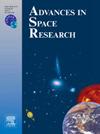Landslide susceptibility prediction based on landform predisposing indexes − An example from the Beiluo River Basin
IF 2.8
3区 地球科学
Q2 ASTRONOMY & ASTROPHYSICS
引用次数: 0
Abstract
The Beiluo River basin, which flows through the central part of the Loess Plateau, has experienced intense soil erosion and significant geomorphic change, which has provided favorable conditions for the occurrence of a large number of landslides. Landform indexes, which can express geomorphologic development state and internal rules, can transfer the development process information of surface morphology into the evaluation of landslide susceptibility, and help get more accurate landslide susceptibility prediction results. Taking the Beiluo River Basin as an example, a landslide susceptibility prediction model based on landform index is proposed by comparing the importance of landform index. In order to improve the accuracy of LSP, 10 kinds of general predictors indexes, 5 kinds of landform predisposing indexes and 1821 landslide points were compiled, and the geographic information system of Beiluo River Basin was constructed. Through the correlation test and CF model, the environmental indexes were evaluated to obtain the sensitive index results, and the combination of different environmental predictors indexes were classified according to the sensitive index results. Based on the combined classification results, the Max Entropy (MaxEnt) model was used to evaluate the Landslide susceptibility prediction (LSP), while the calculated results were evaluated and compared using the receiver operating characteristic (ROC) curve and landslide density. The results show that the vertical erosion factor, elevation, rainfall, horizontal erosion factor, slope angle and NDVI play a key role in controlling the spatial distribution of landslides in the study area. At the same time, the accuracy of landslide susceptibility is compared by AUC value. According to the calculation results, the Group5 (AUC = 0.803) with reasonable terrain index performs better in the training and test stages, and the relative accuracy is improved by 6.22 % compared with the non-introduction of terrain index and the omission rate difference is the best (omission rate difference = 0.0005), indicating that the introduction of landform index can effectively improve the landslide susceptibility prediction. The distribution of different sensitive areas was observed. The high sensitive areas and very high sensitive areas are mainly distributed in the southern Luochuan loess tableland and the northern Wuqi loess hilly area. The research results provide a scientific basis for landslide susceptibility prediction with rational introduction of landform indexes and regional infrastructure construction.
基于地貌易发指数的滑坡易发性预测--以北洛河流域为例
流经黄土高原中部的北洛河流域水土流失严重,地貌变化显著,为滑坡的大量发生提供了有利条件。地貌指标能够表达地貌发育状态和内在规律,可将地表形态的发育过程信息传递到滑坡易发性评价中,有助于获得更准确的滑坡易发性预测结果。以北洛河流域为例,通过比较地貌指数的重要性,提出了基于地貌指数的滑坡易发性预测模型。为了提高 LSP 的精度,编制了 10 种一般预测指标、5 种地貌易发指标和 1821 个滑坡点,并构建了北洛河流域地理信息系统。通过相关性检验和 CF 模型,对环境指标进行评价,得出敏感指标结果,并根据敏感指标结果对不同环境预测指标进行组合分类。根据组合分类结果,使用最大熵(MaxEnt)模型评估滑坡易感性预测(LSP),并使用接收者工作特征曲线(ROC)和滑坡密度对计算结果进行评估和比较。结果表明,垂直侵蚀因子、海拔高度、降雨量、水平侵蚀因子、坡角和 NDVI 在控制研究区域滑坡的空间分布方面起着关键作用。同时,通过 AUC 值比较了滑坡易感性的准确性。计算结果表明,合理引入地形指数的 Group5(AUC = 0.803)在训练和测试阶段表现较好,相对精度比未引入地形指数时提高了 6.22 %,遗漏率差异最佳(遗漏率差异 = 0.0005),表明引入地形指数能有效提高滑坡易感性预测效果。观察了不同敏感区的分布。高敏感区和极高敏感区主要分布在洛川南部黄土台地和吴起北部黄土丘陵区。研究成果为合理引入地貌指标进行滑坡易发性预测和区域基础设施建设提供了科学依据。
本文章由计算机程序翻译,如有差异,请以英文原文为准。
求助全文
约1分钟内获得全文
求助全文
来源期刊

Advances in Space Research
地学天文-地球科学综合
CiteScore
5.20
自引率
11.50%
发文量
800
审稿时长
5.8 months
期刊介绍:
The COSPAR publication Advances in Space Research (ASR) is an open journal covering all areas of space research including: space studies of the Earth''s surface, meteorology, climate, the Earth-Moon system, planets and small bodies of the solar system, upper atmospheres, ionospheres and magnetospheres of the Earth and planets including reference atmospheres, space plasmas in the solar system, astrophysics from space, materials sciences in space, fundamental physics in space, space debris, space weather, Earth observations of space phenomena, etc.
NB: Please note that manuscripts related to life sciences as related to space are no more accepted for submission to Advances in Space Research. Such manuscripts should now be submitted to the new COSPAR Journal Life Sciences in Space Research (LSSR).
All submissions are reviewed by two scientists in the field. COSPAR is an interdisciplinary scientific organization concerned with the progress of space research on an international scale. Operating under the rules of ICSU, COSPAR ignores political considerations and considers all questions solely from the scientific viewpoint.
 求助内容:
求助内容: 应助结果提醒方式:
应助结果提醒方式:


